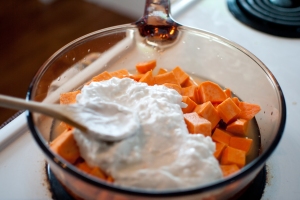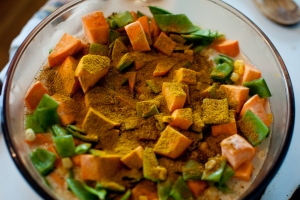I’ll just go ahead and be honest and say that I usually just refer to this recipe as gluten-free curry, but I was a bit worried about being somewhat accurate when referring to foods that are not of North American origin. Curry has always been a mystery to me; is it simply any dish containing curry powder? What is the criteria for something to be considered curry? My knowledge of international cuisine is extremely limited and all I know is that I LOVE Indian food. SO I decided to simply to call this Indian Stew. And this is the part where you foodies all stop rolling your eyes at me.
I’ve made this tons of times. The only ingredients you really need are coconut milk, chicken/vegetable stock or water, and Indian spices. This creates the base and you can add whatever other ingredients your heart desires. It’s a great recipe to clean up the fridge and you can essential toss in any veggies or protein you have on hand.
I used sweet potatoes this time around, but you could also use potatoes, or a mix of both, or any other root vegetable really. I used about 5 large ones and chopped them up into medium sized chunks. I added them to my pot and added a can of coconut milk and an equal part of chicken stock. In this case you want to make sure the chicken (or vegetable) stock you use is gluten free. You could use water as well. What you basically want to do is dilute the coconut milk so it’s not quite so thick. You can play around with the proportions though depending on whether you want this to be more soup-y or stew-y.
Then add whichever other vegetables you like, but two of my favorites for this recipe are corn and peas. I dumped in about a cup and a half of frozen corn and about a cup and a half of chopped fresh sugar snap peas. I also like to use peppers and mushrooms, but had none on hand.
Now for the spices. I don’t measure my spices, or anything else for that matter, but I can tell you that I used a very generous amount. I used equal parts curry powder and indian masala. I’ve used recipes in the past that called for a tablespoon or so of curry powder, and honestly that amount is so small I can barely taste it. Indian spices are so delicious that I really want to be able to taste them when I use them. Here’s before I added the spices:
And After:
You can start with less however and work your way up.
Then all you need to do is stir, turn the stove on to medium-high heat and wait for the sweet potato to soften, about 15 minutes or so. Stir occasionally.
In the past I’ve added pieces of chicken and stew meat to this recipe, and both were delicious. So to summarize:
Ingredients:
4-5 sweet potatoes
1 can coconut milk
1 can chicken stock
1 1/2 cups corn
1 1/2 cups shelled peas or snap peas
indian masala and curry powder to taste
Directions:
Toss everything in a pot and cook on medium-high heat for 15-20 minutes or until sweet potatoes are soft.
As simple as that!






